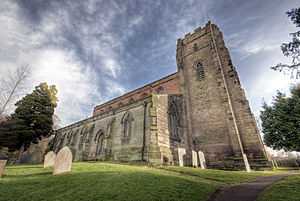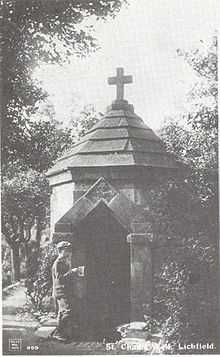Church of St Chad, Lichfield
| Church of St Chad, Lichfield | |
|---|---|
 | |
| 52°41′22″N 1°49′15″W / 52.689373°N 1.820925°WCoordinates: 52°41′22″N 1°49′15″W / 52.689373°N 1.820925°W | |
| Location | Lichfield, Staffordshire |
| Country | England |
| Denomination | Anglican |
| Website | The Church of St Chad |
| Architecture | |
| Functional status | Active |
| Heritage designation | Grade II* |
| Designated | 05.02.1952 |
| Architectural type | Church |
| Style | Early English, Gothic |
| Specifications | |
| Materials | Sandstone & Brick |
| Administration | |
| Parish | Lichfield |
| Diocese | Lichfield |
| Province | Canterbury |
| Clergy | |
| Rector | Revd Rod Clark |
| Curate(s) | Revd Joshua Penduck |
| Minister(s) | Revd Elizabeth Wall |
| Laity | |
| Organist/Director of music | Mitchell Holland |
| Parish administrator | Lisa Mitchell |
The Church of St Chad is a parish church in the area of Stowe in the north of the city of Lichfield, Staffordshire in the United Kingdom. It is a Grade II* Listed Building. The church is located to the north of Stowe Pool on St Chad's Road. The current building dates back to the 12th Century although extensive restorations and additions have been added in the centuries since.
History
Chad came to Lichfield a few years before he became Bishop of Lichfield in 669 CE for the purpose of religious solitude. He settled in a wood and led an eremitical life in a cell by the side of a spring. From this cell he was known to preach and baptize his converts in the spring. It is believed that the location of Chads cell and spring was in the current churchyard.
A monastery named the station of St Chad was built nearby the spring on the present site of the church around the time of St Chad. Of the original Saxon monastery nothing now remains.[1]
During the 12th Century the monastery was rebuilt as a church in stone and consisted of the nave, two side aisles and a chancel. The west door to the church stood where the tower now stands. The windows were set in gables and the lines of these gables and the rounded arches of the Norman windows in the south aisle are some of the oldest features still visible in today's building.[1]
During the 13th Century the roof was replaced, the gables were dispensed with and the walls built up to the level of the window heads. The Norman windows were replaced with the Early English style pointed windows, still seen today. The south arcade of five bays with octagonal pillars is also Early English as is the chancel and the west doorway.[2]
The Tower on the west side was built in the 14th Century to house the bells. The five-light chancel east window with cusped intersecting tracery was also built during this time as was the font, which is still in use today.[2]
During the Reformation many of the church's assets were confiscated. During the English Civil War the church was occupied by Parliamentary troops who besieged the Close of Lichfield, the church was considerably damaged and the roof had to be rebuilt.[1] At this time the red brick clerestory was added and the single overall roof was replaced by three separate roofs, including a grained roof over the nave and panelled roof in the south aisle.[2]
In 1840 the decision was taken to demolish the north aisle and rebuild in a Victorian Gothic style. In 1862 the chancel and chancel arch were thoroughly restored and the brick clerestory extended over the chancel, a vestry was also added to the north side and the porch to the south. Further restoration work took place on the windows, the stained glass in the chancel and the east end of the south aisle seen today dates from this period.[1]
St Chad's Well

St Chad's Well is located in the churchyard to the north west of the church. The well is built over what was a spring and it is reputed that St Chad prayed on a stone at the spring, baptised his converts and healed peoples ailments in its sacred waters. This Holy well had become a popular place of pilgrimage by the 16th Century.
In the 1830s James Rawson, a local physician, saw to it that the water supply was improved and an ornate octagonal stone structure was erected over the well.[3] When the water dried up by the early 1920s, the well was lined with brick and a pump was fitted to the spring that fed it.[4] The stone structure was demolished in the 1950s and was replaced with the simple timber structure with tiled canopy we see today.
The well is still a popular site of pilgrimage for both Anglicans and Catholics and it is traditionally decorated with flowers and greenery in a well dressing ceremony on Holy Thursday. The vines currently covering the canopy are a traditional Christian symbol referring to the Eucharistic wine.
Other Features
Monuments
The monuments in the church include two in the south wall of the chancel with Johnsonian connections. One is to Lucy Porter (d. 1786), Dr. Johnson's step-daughter. Below it is a memorial to Catherine Chambers (d. 1767), servant to Michael Johnson and his family. It was erected in 1910 after her tomb and that of Lucy Porter had been discovered during work on the chancel floor.[4]
A statue of St Chad was placed over the south porch in 1930 by Lady Blomefield in memory of her husband, Sir Thomas Blomefield of Windmill House (d. 1928). In 1949 a screen was erected across the tower arch in memory of Alderman J. R. Deacon (d. 1942) by his widow.[4]
The east end of the south aisle was formed into a Lady chapel in 1952 as a memorial to the fallen of the Second World War.[4]
Bells
St Chad's has four bells in its tower, three of which date from the 17th Century and the fourth has an inscription dated 1255. At the Reformation, St Chad's was reported as having 'three bells and a sanctus bell'.[1]
Gallery
-

St Chads Well as seen today with the wooden structure over it built in the 1950s.
-

Trefoil-headed south door
See also
- St Chad
- Holy Well
References
- ↑ 1.0 1.1 1.2 1.3 1.4 Simkin, D.J. (1983), A Guide to some Staffordshire Churches, Curlew Countryside Publications, ISBN 0-9506585-2-9
- ↑ 2.0 2.1 2.2 Salter, Mike (1996), The Old Parish Churches of Staffordshire (2nd ed.), Folly Publications, p. 60, ISBN 1-871731-25-8
- ↑ Upton, Chris (2001), A History of Lichfield, Phillimore & Co Ltd, p. 10, ISBN 1-86077-193-9
- ↑ 4.0 4.1 4.2 4.3 Lichfield: Churches - British History Online, retrieved 5 August 2010
External links
| Wikimedia Commons has media related to St Chad's church, Lichfield. |